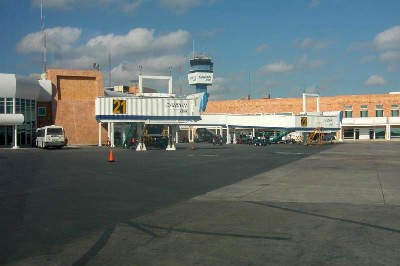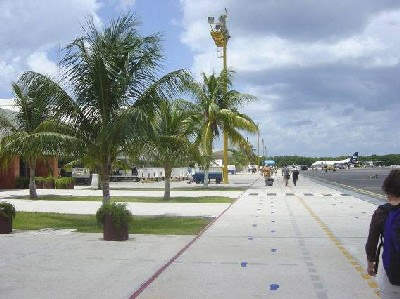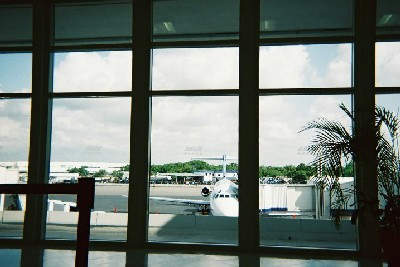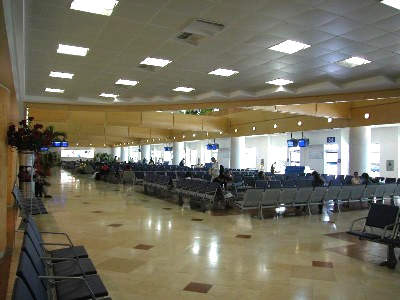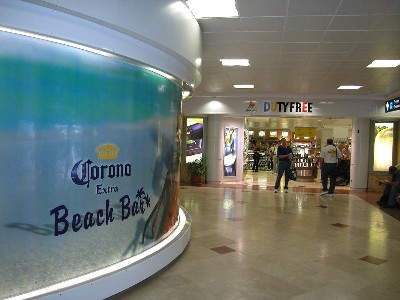Cancun is one of the great playgrounds for American tourists. Every year more and more Americans visit, especially around the time of spring break for US colleges. Because of the popularity of the resort the airport was at times operating well over its design capacity, leading the Mexican authorities to decide to increase the number of terminals from two to three.
Cancun International Airport is located in Quintana Roo, on the Caribbean coast of the Yucatán Peninsula. It is the second busiest airport in Mexico after Mexico City International Airport. In 2010 12.4 million passengers used the airport. It is currently the fourth busiest airport in Latin America, just behind Mexico City and the two main airports in São Paulo.
In May 2007 the new third terminal at Cancun Airport was opened. This is an interim project with further expansion planned at the airport as well as a possible new airport at Tulum (an ideal centre for a resort with its Mayan ruins and excellent beaches).
Cancun has had to recover quickly from the hurricane damage incurred in late 2005. But the city has accomplished this and now features many new hotels, a widened beachfront and a host of other improvements following extensive government and private investment.
A possible downturn was expected at the resort because of the US Government’s mandate that required valid passports for US travellers returning from the country. But the figures showed an increase of 15% in the number of travellers in the first quarter of 2007 compared to 2006.
The airport has one asphalt runway 12/30 of 11,483ft (3,500m) and is operated by Grupo Aeroportuario del Sureste SA de CV (ASUR). The second runway (12L/30R) is 2,800m long. A distance of 1,500m is maintained between the two runways to allow simultaneous take-offs and landings.
Cancun’s new terminal
In May 2007 the Mexican President, Felipe Calderón Hinojosa, and Quintana Roo Governor, Félix González Canto, inaugurated the new third terminal, which required an investment of $100m and now effectively doubles the number of passengers the airport can handle from ten million to 20 million a year. Forecasts expect over 25 million passengers a year by 2017.
The new terminal three facilities include 84 check-in counters and 12 jet-bridge boarding gates and four apron doors, with open public spaces and a variety of services. The advanced security system includes Mexico’s first CT scanning system for all checked baggage.
The number of daily flights to Cancun will increase from 266 to more than 450, and airport officials say they expect to double the number of airlines flying into Cancun within three years. Aldeasa Mexico SA de CV has obtained the lease from ASUR for the operation of the duty free shop located in terminal three. The new duty free shop covers 1,800m² and has a walk-through layout. Features of the new terminal include:
- An advanced security system that screens all hold and cabin baggage, and complies with new international aviation security regulations
- A total area of more than 40,000m²
- 84 check-in counters
- 12 boarding gates with boarding bridges, and another four for remote stands
- State-of-the-art passenger information FID (Flight Information Display) systems
New runway
On 20 October 2010, the airport’s second runway was opened. Completed at an investment of $67m, the new runway has increased the airport’s handling capacity to more than 28 million passengers per year. The runway also includes an airplane bridge with a taxiway.
ASUR received the necessary land for the second runway in Cancun in concession from the Mexican Federal Government in December 2005. The studies recommending the second runway were completed in mid-2006.
The second runway at Cancun Airport has doubled the current capacity for air-traffic movements.
Cancun airport facilities
The airport has two other terminals. Terminal one serves all charter flights, while terminal two and a connected satellite building serve all national and international scheduled flights.
These two terminals together comprise 45 boarding gates, 12 in terminal one and 33 (A1-A11 and B1-B22) in terminal two.
As of September 2006, Cancun Airport has also boasted wireless check-in facilities. The airport has installed ten additional mobile counters to check-in passengers and print boarding passes anywhere in the airport concourse. The mobile counters rely on a wireless connection to the airport’s information technology systems and the Common Use Terminal Equipment (CUTE) standard as well as built-in power sources using rechargeable batteries.
L-3 Communications (security and detection systems subsidiary) provided a range of systems that automatically screen check baggage for explosives to Cancun and several other ASUR airports. The first phase of the rollout included nine eXaminer 3DX systems, four VIS 108 systems and four VDS 108 systems.
In October 2010, a new 315ft tall control tower was opened at the airport.

